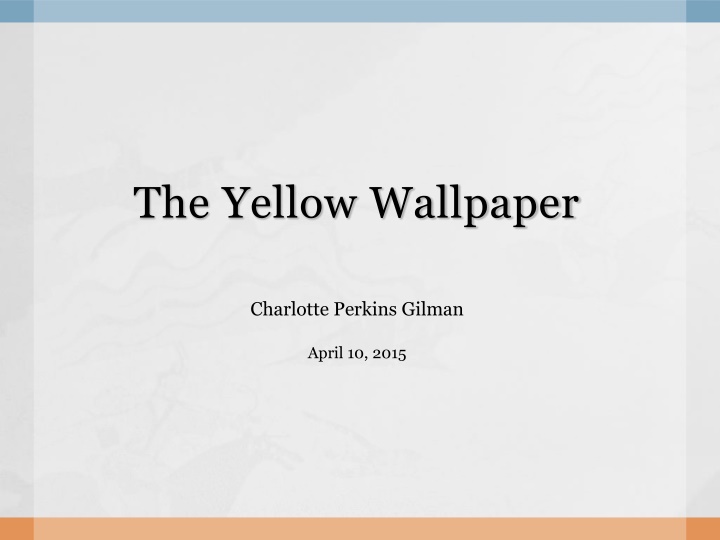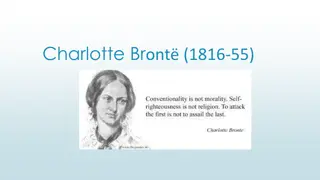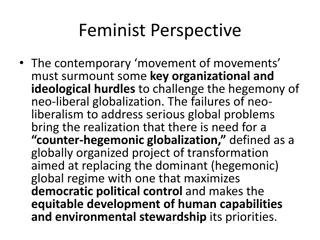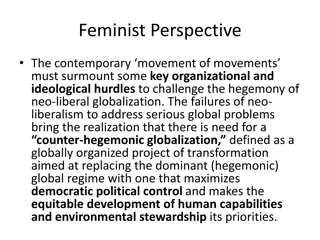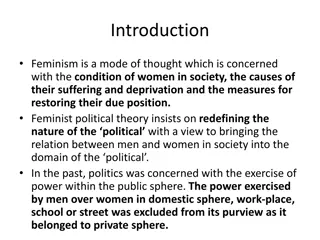The Yellow Wallpaper by Charlotte Perkins Gilman – A Feminist Classic
The Yellow Wallpaper is a powerful feminist classic by Charlotte Perkins Gilman, exploring the oppressive medical treatment of women in the 19th century. Through the story of a woman confined to a room, Gilman critiques gender roles, societal expectations, and the marginalization of women's voices, culminating in a chilling portrayal of the protagonist's descent into madness as a form of protest. With themes of control, autonomy, and mental health, the novella remains a poignant critique of the patriarchy and a call for women's liberation.
Download Presentation

Please find below an Image/Link to download the presentation.
The content on the website is provided AS IS for your information and personal use only. It may not be sold, licensed, or shared on other websites without obtaining consent from the author.If you encounter any issues during the download, it is possible that the publisher has removed the file from their server.
You are allowed to download the files provided on this website for personal or commercial use, subject to the condition that they are used lawfully. All files are the property of their respective owners.
The content on the website is provided AS IS for your information and personal use only. It may not be sold, licensed, or shared on other websites without obtaining consent from the author.
E N D
Presentation Transcript
The Yellow Wallpaper Charlotte Perkins Gilman April 10, 2015
Gilman(1860-1935) Married twice, once with a local artist called Walter Stetson, later with her first cousin George Houghton Gilman with whom she lived over 30 year. She killed herself after being diagnosed as having an inoperable breast cancer.
A Utopian Feminist and Socialist proposing community kitchens and childcare centers as a way of reducing the burden of domestic work on women and allowing them to contribute to society in other ways, by working on equal terms with men in Women and Economic
Weir Mitchells treatment prescribing complete isolation and bed rest; to begin with, the patient was not allowed to talk to others, nor to read, write, do any other kind of practical activity or even feed herself. telling Charlotte to devote herself entirely to domestic work, and to raising her child, to do no more than two hours reading a day, and 'never touch pen, brush or pencil as long as you live'.
The Yellow Wallpaper initially seen as a horror story, in the tradition of Edgar Allan Poe, but now as an angry, but chillingly controlled, attack on the author's treatment in Mitchell's sanatorium seeing the figure of a woman 'creeping about' behind the pattern at night, trying to get out, clearly an alter ego for the narrator herself, who ends up ripping the wallpaper off, locking herself in the room and 'creeping' across the floor.
Gilmans own words on the novel the narrator's insanity as a way to protest the medical and professional oppression against women at the time. the outbreak of women being diagnosed as mentally ill was the manifestation of their setbacks regarding the roles they were allowed to play in a male-dominated society.
Feminist Interpretation a condemnation of the androcentric hegemony of the 19th-century medical profession focusing on the degree of triumph at the end of the story.
Reading and Writing as Gendered Practices allowed neither to write in her journal nor to read, she would begin to "read" the wall paper until she found the escape she was looking for. At the end of the story, as her husband lies on the floor unconscious, she crawls over him, symbolically rising over him. This is interpreted as a victory over her husband, at the expense of her sanity.
The Subordination of Married Women The story reveals that this gender division had the effect of keeping women in a childish state of ignorance and preventing their full development. John s assumption of his own superior wisdom and maturity leads him to misjudge, patronize, and dominate his wife, all in the name of "helping" her.
The Importance of Self-Expression The narrator s eventual insanity is a product of the repression of her imaginative power, not the expression of it. She is constantly longing for an emotional and intellectual outlet, even going so far as to keep a secret journal, which she describes more than once as a "relief" to her mind.
Wallpaper as a Symbol representing the structure of family, medicine, and tradition in which the narrator finds herself trapped. Wallpaper is domestic and humble, and Gilman skillfully uses this nightmarish, hideous paper as a symbol of the domestic life that traps so many women. Being able to read the woman figure is recognizing her own identity.
Exposition John is practical in the extreme. He has no patience with faith, and intense horror of superstition, and he scoffs openly at any talk of things not to be felt and seen and put down in figures. John is a physician, and perhaps-(I would not say it to a living soul, of course, but this is dead paper and a great relief to my mind-) perhaps that is one reason I do not get well faster.
Fantasy starts There are things in that paper that nobody knows but me, or ever will. Behind that outside pattern the dim shapes get clearer every day. It is always the same shape, only very numerous. And it is like a woman stooping down and creeping about behind that pattern. I don t like it a bit. I wonder-I begin to think-I wish John would take me away from here!
Fantasy develops At night in any kind of light, in twilight, candlelight, lamplight, and worst of all by moonlight, it becomes bars! The outside pattern I mean, and the woman behind it is as plain as can be. I didn t realize for a long time that the thing was that showed behind, that dim sub-pattern, but now I am quite sure it is a woman.
The moment of Change Then she said that the paper stained everything it touched, that she had found yellow smooches on all my clothes and John's, and she wished we would be more careful! Did not that sound innocent? But I know she was studying that pattern, and I am determined that nobody shall find it out but myself! Life is very much more exciting now than it used to be. You see I have something more to expect, to look forward to, to watch. I really do eat better, and am more quiet than I was.
Ending "What is the matter?" he cried. "For God's sake, what are you doing! I kept on creeping just the same, but I looked at him over my shoulder. "I've got out at last," said I, "in spite of you and Jane. And I've pulled off most of the paper, so you can't put me back!" Now why should that man have fainted? But he did, and right across my path by the wall, so that I had to creep over him every time!
